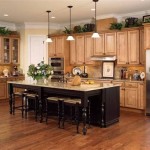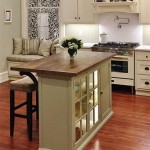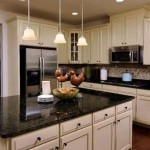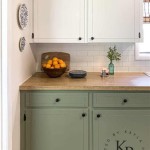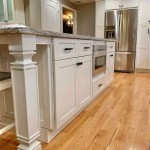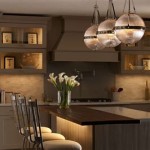How Long Should My Cabinet Pulls Be?
Selecting the appropriate size cabinet pull is a crucial component of kitchen and bathroom design, impacting both the aesthetic appeal and functional usability of cabinetry. Determining the ideal length involves considering a range of factors, including cabinet size, style, overall design scheme, and personal preference. This article will explore the key considerations to guide the selection process of cabinet pull lengths, ensuring a harmonious balance between form and function.
Understanding the Importance of Proportion
The concept of proportion is paramount in interior design, and cabinet hardware is no exception. The length of a cabinet pull should be visually proportionate to the size of the cabinet door or drawer it adorns. Using pulls that are too small on large cabinets can appear insignificant and make the cabinet difficult to open. Conversely, excessively large pulls on small cabinets can overwhelm the space and look disproportionate.
A common guideline is the "one-third rule." This rule suggests that the pull length should ideally be approximately one-third of the cabinet door or drawer's width. For example, a 12-inch wide drawer would ideally feature a pull around 4 inches in length. However, this rule serves as a starting point and should be adjusted based on individual preferences and the specific design context.
For larger drawers, particularly those exceeding 30 inches in width, it is often more aesthetically pleasing and functionally advantageous to use two pulls instead of a single long pull. This distributes the weight more effectively and provides a more balanced appearance. The placement of these pulls can also be strategically determined, often positioned near the corners or at visually balanced points.
In situations where a specific pull style is desired but the available sizes don't perfectly align with the one-third rule, adjustments can be made. Opting for a slightly shorter pull is generally preferable to selecting one that is noticeably too long. The goal is to achieve a visual harmony that complements the cabinetry and the surrounding space.
Considering Cabinet Style and Design Aesthetic
The overall style of the cabinetry and the broader design aesthetic of the room significantly influence the appropriate length and style of cabinet pulls. Different design styles call for different hardware choices to maintain a cohesive and visually appealing look.
In contemporary or minimalist kitchens, longer, sleek pulls are often favored. These pulls contribute to the clean lines and uncluttered aesthetic characteristic of these styles. Bar pulls, which are typically longer and have a minimalist design, are a common choice. The length of these pulls can often extend across a significant portion of the drawer or door, creating a bold visual statement.
For more traditional or farmhouse-style kitchens, shorter, more decorative pulls are often preferred. These pulls may feature intricate details, such as curves, embellishments, or antique finishes. Cup pulls are a popular choice for drawers in these styles, providing a vintage or rustic feel. The length of these pulls is typically shorter, emphasizing the decorative aspects rather than the streamlined functionality of modern pulls.
Transitional kitchens, which blend elements of traditional and contemporary design, offer more flexibility in hardware selection. The choice of pull length and style will depend on the specific balance between traditional and modern elements within the kitchen. A medium-length pull with a simple design can often bridge the gap between these styles, providing a versatile and aesthetically pleasing option.
Beyond the specific style of the cabinetry, the finish of the pulls should also complement the other elements in the room, such as the appliances, faucets, and lighting fixtures. Coordinating the finishes creates a unified and harmonious design scheme. Common finishes include brushed nickel, polished chrome, matte black, and antique brass, each offering a distinct visual appeal.
Functional Considerations and Accessibility
While aesthetics play a crucial role in the selection of cabinet pulls, functionality and accessibility are equally important. The pulls should be easy to grip and use, especially for individuals with limited mobility or dexterity. The length and projection of the pull can significantly impact its ease of use.
Longer pulls generally offer a more comfortable grip, particularly for larger drawers or cabinets. The increased surface area allows for a more secure hold, reducing the strain on hands and wrists. However, excessively long pulls can sometimes protrude too far, potentially posing a safety hazard or obstructing movement within the kitchen.
The projection of the pull, which is the distance it extends from the cabinet surface, is another important consideration. A sufficient projection is necessary to allow adequate space for fingers to grip the pull comfortably. However, an excessive projection can create a bulky appearance and may interfere with the opening and closing of adjacent cabinets or drawers.
For individuals with disabilities or mobility limitations, lever-style pulls or D-shaped pulls can be particularly beneficial. These pulls provide a larger gripping surface and require less force to operate. The length of these pulls is often chosen to maximize ease of use while maintaining a visually appealing aesthetic.
Consideration should also be given to the placement of the pulls on the cabinet doors and drawers. The pulls should be positioned in a location that is easily accessible and comfortable to reach. For upper cabinets, pulls are typically placed near the bottom corner of the door, while for lower cabinets, they are often placed near the top corner. The specific placement may vary depending on the cabinet style and the overall design of the kitchen.
In summary, selecting the ideal length for cabinet pulls requires a thoughtful consideration of proportion, style, and functionality. The one-third rule provides a useful starting point, but adjustments should be made based on the specific characteristics of the cabinetry and the overall design aesthetic. Functional considerations, such as ease of grip and accessibility, should also be taken into account to ensure that the pulls are both visually appealing and practical to use. By carefully balancing these factors, it is possible to choose cabinet pulls that enhance the beauty and functionality of any kitchen or bathroom.
Ultimately, the correct length of cabinet pulls lies in a blend of observation, measurement, and subjective judgment. There isn’t a single answer that will cover all scenarios, but relying on these principles should provide a good starting point for the ideal solution.

The Right Length Cabinet Pulls For Doors And Drawers Porch Daydreamer

How To Choose Hardware Pull Size For Your Cabinets
How To Choose The Best Size Pulls For Your Cabinets Trubuild Construction
Cabinet Hardware Sizing Guide The Knobbery Door Bath Accessories Faucets Furniture Knobs And Pulls
Cabinet Hardware Sizing Guide The Knobbery Door Bath Accessories Faucets Furniture Knobs And Pulls
How To Choose The Best Size Pulls For Your Cabinets Trubuild Construction
Cabinet Hardware Sizing Guide The Knobbery Door Bath Accessories Faucets Furniture Knobs And Pulls
How To Choose The Best Size Pulls For Your Cabinets Trubuild Construction
How To Choose The Best Size Pulls For Your Cabinets Trubuild Construction

How To Place Cabinet Knobs Pulls
Related Posts

